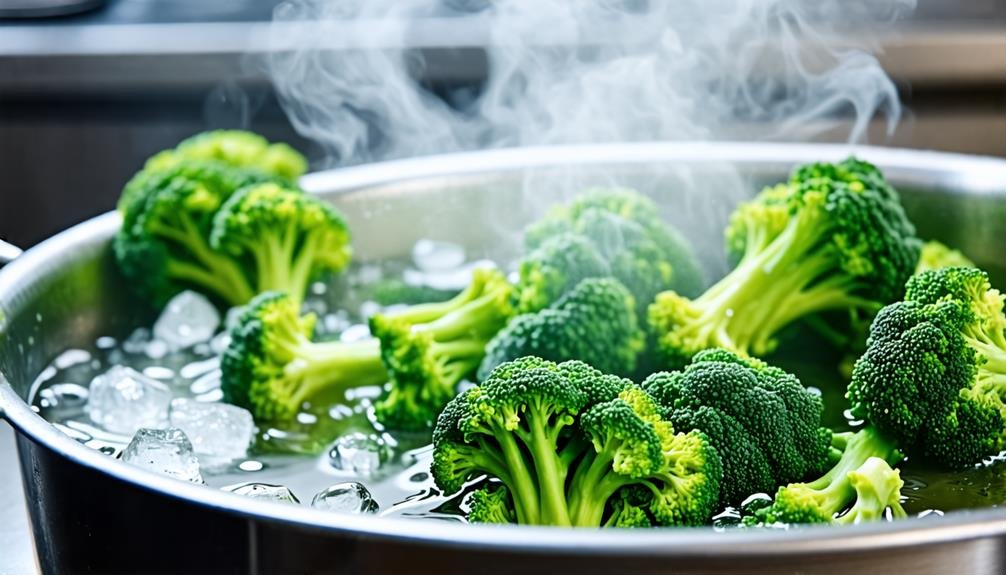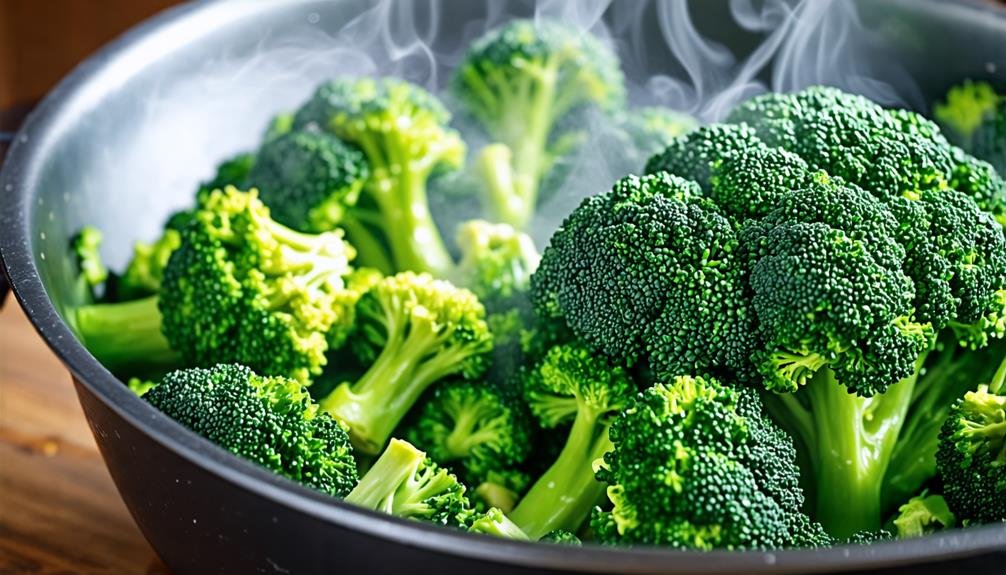Common mistakes in boiling broccoli often lead to a disappointing culinary outcome. Overcooking is the primary issue, which results in a dull, lifeless appearance and significant nutrient loss. To prevent this, aim to boil broccoli for only 2 to 3 minutes, maintaining its vibrant green color and slight crunch. Another crucial technique is blanching; after boiling, immediately transfer the broccoli to an ice bath to halt the cooking process. Enhancing flavor while preserving texture can be achieved by seasoning with sea salt or olive oil. Understanding these key methods can uplift your broccoli preparation, ensuring it remains a nutritious and appealing dish, so stay tuned for further insights.
Understanding Overcooking Risks
Overcooking broccoli results in a loss of its vibrant green hue, essential nutrients, and appealing crispness. This common error can significantly diminish the health benefits and culinary attractiveness of this nutrient-dense vegetable. When broccoli is overcooked, its cellular structure breaks down, leading to a limp and unappetizing appearance. A dull, lifeless look replaces the bright color and crunch that make broccoli visually appealing.
More critically, overcooked broccoli loses vital nutrients, such as vitamin C and various antioxidants, which are necessary for overall well-being. While boiling can effectively soften the vegetable, prolonged cooking time accelerates nutrient loss. To avoid overcooking broccoli, it is crucial to keep a close eye on cooking times and use methods that stop the cooking process at the right moment.
Techniques like blanching can help prevent the negative effects of overcooking. By immediately placing broccoli in an ice bath after boiling, one can maintain its texture, color, and nutritional benefits. This method enhances the dish and allows individuals to enjoy broccoli at its best, promoting a healthier lifestyle.
Ideal Boiling Time for Broccoli
To achieve the ideal boiling time for broccoli, aim for 2 to 3 minutes. This brief cooking duration keeps the vegetable vibrant and slightly crunchy. Broccoli florets should remain bright green and tender yet firm. Overcooking leads to a mushy texture and dull appearance.
Monitor the florets closely while boiling. At the two-minute mark, taste a floret to check for your desired texture. If it’s perfect, promptly remove the broccoli from the boiling water.
To stop the cooking process and prevent further softening, place the broccoli in ice water immediately after boiling. This step helps maintain its vibrant color and crispness. Following these guidelines will ensure perfectly boiled broccoli that enhances any dish.
Benefits of Blanching Explained

Blanching broccoli after boiling is a beneficial cooking technique. It helps retain the vegetable’s vibrant green color and essential nutrients. This method enhances both the visual appeal and nutritional value of the dish.
- Color Preservation: Blanching keeps broccoli’s bright green color, making it more attractive on the plate.
- Nutrient Retention: This process reduces the loss of vitamins and minerals during boiling, leading to a healthier meal.
- Texture Control: By quickly immersing broccoli in cold water, blanching avoids overcooking, ensuring a satisfying crispness.
- Flavor Boost: The rapid cooling can enhance the natural flavors of broccoli, making it tastier.
Using blanching in your cooking routine improves the quality of your broccoli, allowing you to serve a dish that is both nutritious and visually appealing. This technique supports your culinary creativity and expression.
Techniques for Proper Blanching
Blanching broccoli properly enhances its color, nutrients, and texture. First, prepare an ice bath using a large bowl filled with cold water and ice. Next, bring a pot of water to a rapid boil, then submerge the broccoli florets for 2-3 minutes. Keep an eye on the vibrant green color as it cooks.
Once the time is up, quickly transfer the broccoli using a slotted spoon to the ice bath. This step stops the cooking process, preserving the desired crispness. Leave the broccoli in the ice water for the same duration it was boiled to ensure thorough cooling.
After blanching, gently pat the broccoli dry with a kitchen towel to eliminate excess moisture. This step enhances flavor concentration and presentation. By using these blanching techniques, you can enjoy broccoli that is colorful and packed with nutrients, making your dishes both healthy and visually appealing.
Enhancing Broccoli Texture and Flavor

Enhancing broccoli’s texture and flavor transforms it into a delightful dish.
Cooking Techniques:
- Timing: Boil broccoli for 2-3 minutes. This short duration keeps it bright green and crisp.
- Blanching: Quickly transfer the boiled florets to an ice bath. This halts cooking and preserves nutrients.
- Seasoning: After blanching, sprinkle with sea salt or drizzle with extra virgin olive oil to boost its natural taste.
- Serving: Serve the broccoli warm. This maintains its appealing crunch and vibrant flavor.
Utilizing these methods can elevate broccoli from a simple vegetable to a standout side. Mastering these techniques ensures your broccoli not only looks appetizing but also offers a satisfying crunch and rich flavor, enhancing your overall dining experience.









